Related Research Articles
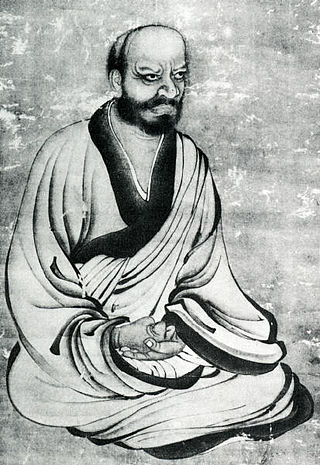
Linji Yixuan was the founder of the Linji school of Chan Buddhism during Tang Dynasty China.

Chinese Buddhism or Han Buddhism is a Chinese form of Mahayana Buddhism which has shaped Chinese culture in a wide variety of areas including art, politics, literature, philosophy, medicine and material culture. Chinese Buddhism is the largest institutionalized religion in Mainland China. Currently, there are an estimated 185 to 250 million Chinese Buddhists in the People's Republic of China. It is also a major religion in Taiwan, Singapore, and Malaysia, as well as among the Chinese Diaspora.
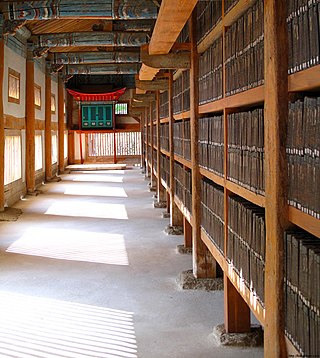
East Asian Buddhism or East Asian Mahayana is a collective term for the schools of Mahāyāna Buddhism that developed across East Asia which follow the Chinese Buddhist canon. These include the various forms of Chinese, Japanese, Korean, and Vietnamese Buddhism in East Asia. East Asian Buddhists constitute the numerically largest body of Buddhist traditions in the world, numbering over half of the world's Buddhists.
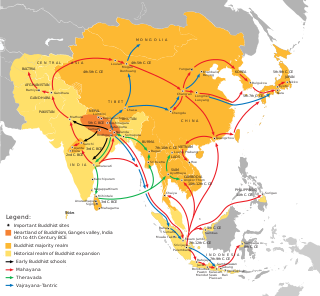
The history of Buddhism can be traced back to the 5th century BCE. Buddhism arose in Ancient India, in and around the ancient Kingdom of Magadha, and is based on the teachings of the ascetic Siddhārtha Gautama. The religion evolved as it spread from the northeastern region of the Indian subcontinent throughout Central, East, and Southeast Asia. At one time or another, it influenced most of Asia.
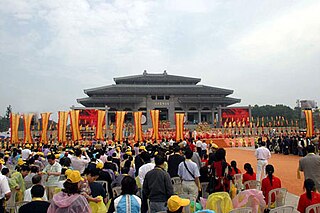
In the study of comparative religion, the East Asian religions or Taoic religions, form a subset of the Eastern religions. This group includes Chinese religion overall, which further includes Ancestral Worship, Chinese folk religion, Confucianism, Taoism and popular salvationist organisations, as well as elements drawn from Mahayana Buddhism that form the core of Chinese and East Asian Buddhism at large. The group also includes Japanese Shinto, Tenrikyo, and Korean Muism, all of which combine Shamanistic elements and indigenous ancestral worship with various influences from Chinese religions. Chinese salvationist religions have influenced the rise of Japanese new religions such Tenriism and Korean Jeungsanism; as these new religious movements draw upon indigenous traditions but are heavily influenced by Chinese philosophy and theology.
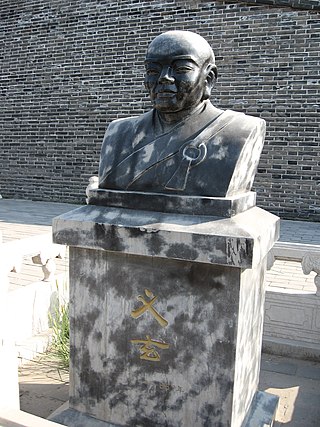
The Línjì school is a school of Chan Buddhism named after Linji Yixuan. It took prominence in Song China (960–1279), spread to Japan as the Rinzai school and influenced the nine mountain schools of Korean Seon.

Jingci Temple is located at the foot of Huiri Peak of Nanping Hill. It is the second prominent Buddhist temple beside West Lake in Hangzhou, China. Together with Lingyin Temple, it is called the jewel of the southern and northern hills. The temple was claimed as a key national Buddhist temple in Han areas by the State Council in 1983.
Zen is a school of Mahayana Buddhism that originated in China during the Tang dynasty, known as the Chan School, and later developed into various sub-schools and branches. From China, Chán spread south to Vietnam and became Vietnamese Thiền, northeast to Korea to become Seon Buddhism, and east to Japan, becoming Japanese Zen.
The Fayan school, or Fayan House was one of the Five Houses of Chán, the major schools of Chan Buddhism during the later Tang dynasty.

Yongjia Xuanjue, also known as Yongjia Zhenjue, was a Zen and Tiantai Buddhist monk who lived during the Tang dynasty. The name Yongjia is derived from the city of his birth, which is now called Wenzhou. He is also known by his nickname "The Overnight Guest" because of his first encounter with his teacher, Huineng. On a visit to Caoxi (漕溪), where Huineng's Nanhua Temple is located, Yongjia was convinced to stay just one night, during which his enlightenment was acknowledged. He supposedly died while meditating in 713. He is best remembered today as the author of the Song of Enlightenment, often known by its Japanese name Shodoka (證道歌). This work remains popular in contemporary Zen practice.

Chan, from Sanskrit dhyāna, is a Chinese school of Mahāyāna Buddhism. It developed in China from the 6th century CE onwards, becoming especially popular during the Tang and Song dynasties.
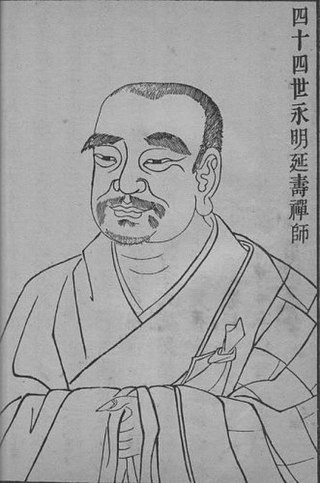
Yongming Yanshou (904–976) was a prominent Buddhist monk during the Five Dynasties and Ten Kingdoms period and early Song Dynasty in China.
Though Zen is said to be based on a "special transmission outside scriptures" which "did not stand upon words", the Zen-tradition has a rich doctrinal and textual background. It has been influenced by sutras such as the Lankavatara Sutra, the Vimalakirti Sutra, the Avatamsaka Sutra, and the Lotus Sutra.
Zen lineage charts depict the transmission of the dharma from one generation to another. They developed during the Tang dynasty, incorporating elements from Indian Buddhism and East Asian Mahayana Buddhism, but were first published at the end of the Tang.
Xuefeng Yicun (822-908) was a Chinese Chan-master who was influential during the Tang Dynasty. The Yunmen school and Fayan school originated with descendants of his lineage.

Thiền Buddhism is the Vietnamese version of Zen Buddhism. Thiền is the Sino-Vietnamese pronunciation of the Middle Chinese word 禪 (chán), an abbreviation of 禪那 (chánnà), which is a transliteration of the Sanskrit word dhyāna ("meditation").
The Zen tradition is maintained and transferred by a high degree of institutionalisation, despite the emphasis on individual experience and the iconoclastic picture of Zen.
Modern scientific research on the history of Zen discerns three main narratives concerning Zen, its history and its teachings: Traditional Zen Narrative (TZN), Buddhist Modernism (BM), Historical and Cultural Criticism (HCC). An external narrative is Nondualism, which claims Zen to be a token of a universal nondualist essence of religions.
Chinese Esoteric Buddhism refers to traditions of Tantra and Esoteric Buddhism that have flourished among the Chinese people. The Tantric masters Śubhakarasiṃha, Vajrabodhi and Amoghavajra, established the Esoteric Buddhist Zhenyan tradition from 716 to 720 during the reign of Emperor Xuanzong of Tang. It employed mandalas, mantras, mudras, abhiṣekas, and deity yoga. The Zhenyan tradition was transported to Japan as Shingon Buddhism by Kūkai as well as influencing Korean Buddhism. The Song dynasty (960–1279) saw a second diffusion of Esoteric texts. Esoteric Buddhist practices continued to have an influence into the late imperial period and Tibetan Buddhism was also influential during the Yuan dynasty period and beyond. In the Ming dynasty (1368–1644) through to the modern period, esoteric practices and teachings became absorbed and merged with the other Chinese Buddhist traditions to a large extent.

The History of Chinese Buddhism begins in the Han Dynasty, when Buddhism first began to arrive via the Silk Road networks. The early period of Chinese Buddhist history saw efforts to propagate Buddhism, establish institutions and translate Buddhist texts into Chinese. The effort was led by non-Chinese missionaries from India and Central Asia like Kumarajiva and Paramartha well as by great Chinese pilgrims and translators like Xuanzang.
References
- ↑ Pascal Albright (19 February 2018). "UA department of East Asian Studies expands with new Korean minor". Daily Wildcat.
- ↑ Harold Coward (2014). Fifty Years of Religious Studies in Canada: A Personal Retrospective. Wilfrid Laurier University Press. p. 101. ISBN 978-1771121033.
- ↑ Steven Heine; Dale S. Wright (2004). The Zen Canon: Understanding the Classic Texts. Oxford University Press. p. 12. ISBN 978-0195150674.
- ↑ Arvind Sharma; Madhu Khanna (2013). Asian Perspectives on the World's Religions after September 11. ABC-CLIO. p. 254. ISBN 978-0313378973.